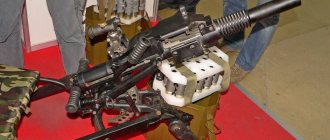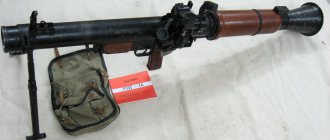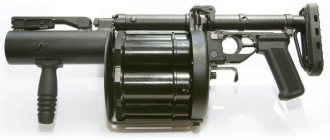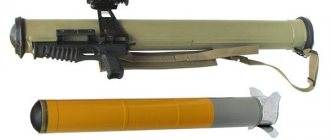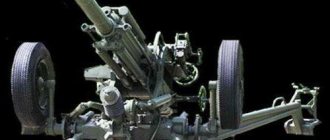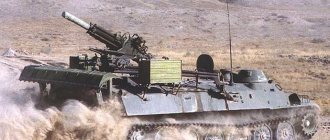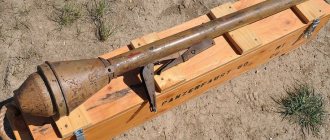AGS-30 is a 30-mm Russian mounted grenade launcher, developed in the early 90s at the Tula Mechanical Engineering Design Bureau. It was put into service in 1995 and is expected to completely replace the famous AGS-17 “Plamya” in the future.
The production of the AGS-30 easel grenade launcher was launched at the Degtyarev plant; since 2008, KZTA JSC has been producing it.
Like its predecessor, the AGS-17 “Flame,” the new product of the Tula gunsmiths is designed to destroy enemy personnel located openly, as well as in trenches, on reverse slopes of heights, or hidden in the folds of the terrain. Also, from the AGS-30 you can hit unarmored enemy vehicles and their firing points.
The AGS-30 is considered a second-generation weapon; it was created taking into account the experience of using the AGS-17 “Flame” grenade launcher in the Afghan conflict and other local wars at the end of the last century. The AGS-30 was used in the second Chechen campaign, in the war with Georgia in 2008, and is currently being used in the civil conflict in Syria.
CONTENT:
- Automatic grenade launcher on the AGS-17 Flame machine
- Automatic grenade launcher on the AGS 30 machine
- Automatic mounted grenade launcher AGS-40 Balkan
The ammunition for it was developed on the basis of the standard Dyakonov rifle grenade. Despite the novelty and demand for this type of weapon, the Ag-2 could not get a start in life.
The reason was the technical imperfection of the product and the complexity of production (special grades of steel and many milled parts). Nevertheless, the idea of such a weapon, capable of targeting infantry at ranges exceeding 1 km, was in the minds of military personnel and designers. And it had to be implemented urgently after the successful creation and use in the Vietnam War of the AGS Mk.19 mod.1 and mod.2, created by the Americans. These grenade launchers were far from ideal, but caused damage to Viet Cong units.
The idea of combining the high rate of fire and lethality of hand grenades was embodied in the AGS-17 automatic grenade launcher.
Device
You may be interested in: How to catch pheasants: effective traps, tips
Like the RPG (anti-tank hand grenade launcher), the Spear LNG is presented in the form of a system in which the initial velocity is transferred to the grenade as a result of combustion of a gunpowder charge in the barrel channel. When the starting charge burns, the resulting gases begin to press on the grenade, which is then driven to maximum speed by its jet engine. The easel grenade launcher fires PG-9 grenades. This ammunition has a caliber warhead, which has a piezoelectric fuse and a jet engine. The latter contains a six-blade stabilizer and two tracers. The starting charge is equipped with a metal charger in the form of a perforated tube, a sample of nitroglycerin-based gunpowder, a boost unit and a DRP ignition charge, which uses an electric igniter.
Automatic grenade launcher on the AGS-17 Flame machine
“Flame” was the name of the development work that resulted in the AGS 17 and this became its unofficial name. The shot was developed at JSC State Research and Production Enterprise Basalt (at that time GSKB-47). It received the name VOG-17 - a fragmentation grenade launcher shot for the AGS-17.
Ags 17 is designed to destroy manpower and unarmored fire weapons in open space and behind cover. In addition to the easel version, versions of the AGS 17 have been developed for installation on helicopters and airplanes in gun containers and a version for armored boats. For armored vehicles there is an option installed in a remotely controlled installation.
The longest firing range is 1700 meters. Shooting can be carried out along a flat trajectory or along a mounted one (from closed positions).
Canopy shooting provides the best destruction of infantry in trenches and shelters. There is a mechanical and optical sight PAG-17.
Since 1971 (the year of adoption), the grenade launcher has been improved several times. But the VOG 17 shot-grenade was subject to constant modernization. The first operational experience showed insufficient reliability of the fuse. This is how the VOG 17M shot with the new VGM-M fuse appeared; it ensured the detonation of ammunition when it encountered almost any surface.
The fragmentation part of the grenade was constantly modernized. During the rework, it was possible to increase the radius of continuous damage from five to seven meters. This is how new shots appeared for the VOG-30, VOG-30D, GPD-30 grenade launchers. All grenades had a self-destruct device with a delay of about 14 seconds. This made it possible not to fear an accidental explosion on an unexploded ordnance.
Performance characteristics of AGS-17
Caliber AGS-17- 30 mm
Weight of AGS-17 - Grenade launcher with mounting and sight - 31 kg - Grenade launcher body: 18 kg - Boxes with grenades: 14.5 kg Dimensions of AGS-17 - Length, mm: 840 mm - Barrel length, mm: 305 mm Rate of fire AGS- 17 - 50-100 (single); 350—400 (bursts) rounds/min AGS-17 projectile speed—185 m/s
Firing range of AGS-17 - 1700 meters sighting Crew - 2 people
All this made the AGS a truly formidable weapon, capable of hitting enemy personnel at a considerable distance. But time does not stand still and the “old man” has been replaced by a new grenade launcher.
TTX
The mounted anti-tank grenade launcher “Spear” has the following tactical and technical characteristics:
- Weighs 47.5 kg.
- Equipped with a 12 kg tripod machine.
- The total length is 211 cm, the trunk is 85 cm.
- The grenade (PG-9V) has an initial speed of 435 m/s, OG-9V - 316 m/s.
- The projectile moves towards the target at a maximum speed of 700 m/s.
- The maximum combat range for an anti-tank grenade is 1300 m, for an anti-personnel grenade - 4500 m.
- A direct shot is possible at a distance of 800 m.
- The PG-9V projectile penetrates armor 3 cm thick, the PG-9VS - 4 cm.
- Within a minute, 6 shots can be fired from LNG.
Automatic grenade launcher on the AGS 30 machine
This model replaced the already obsolete AGS 17. The new grenade launcher was put into service in 1995. Reduced dimensions and weight up to 16.5 kg made it more mobile and effective in real combat. The crew could have taken more ammunition. And the assembled AGS-30 could carry one calculation number.
Small dimensions and a special, improved design of the tripod provided greater mobility and the ability to quickly change positions. At the same time, the unification of ammunition is ensured. The AGS30 can fire both the old VOG-17 and the VOG-30 specially developed for it.
The new VOG-30 ammunition deserves special attention - a new production technology was used here. The cold deformation method made it possible to obtain a set of semi-finished fragments with sharp edges. This made it possible to strengthen the fragmentation field and increase its power by 1.5 times.
One shot of VOG 30 weighing 350 g. allows you to hit an area of 10 by 10 m. And a specially designed high-explosive fragmentation round GPD-30 covers an area of 130 m2. At the same time, the problem of defeating personnel wearing personal protective equipment - body armor and helmets up to class 3 - has been solved.
Another advantage of the AGS-30 is its increased firing range to 2200 m. The predecessor fired only at 1700 m. This was achieved by reducing the drag of the projectile in flight, and not by increasing the powder charge and, accordingly, altering the weapon mechanics. At the same time, the accuracy of fire increased.
The grenade is cocked into firing position at a distance of 30-60 meters after the shot. This allows the AGS-30 crew to not be damaged in case of abnormal operation of the fuse. The instantaneous fuse provides a guaranteed detonation upon contact with any surface - loose snow, water.
Performance characteristics of AGS-30:
Caliber – 30 mm. Grenade – 30x29 mm. Overall dimensions (with a tripod machine) – 1165x735x490 mm. Weight without cartridge box and sight - 16.5 kg. Rate of fire – up to 400 rounds/min. The initial speed of the grenade is 185 m/s. The capacity of the cartridge box is 30 shots. Sighting range - up to 1700 m (VOG-17, VOG-17M and VOG-30 rounds), up to 2200 m (GPD-30 rounds). Calculation - two people.
Good combat characteristics allow the AGS-30 to remain in service to this day. But we must not forget that the standard shot for AGS in NATO is a 40X53 mm grenade, that is, 40 and not 30 mm caliber.
And now the time has come for a more modern and powerful installation.
Sights
The AGS-17 manual includes instructions for using, in addition to the main mechanical sight, also the PAG-17 prismatic optical sight. In the case of direct fire at distances of up to 700 meters, it is easier for the crew to do without optics. PAG-17 is needed for firing from closed positions or at distant targets. Its design allows it to also be used as a range finder if the dimensions of the object are known. The lens is equipped with light filters, there are two of them. One has a neutral color and slightly reduces the light intensity in sunny weather, the other is designed for aiming at dusk and is made using a brightening orange optical layer. The sighting marks are applied in the form of corners and strokes, with division values of 100 and 50 meters, respectively. On the sides of the central crosshair there are lateral correction icons. Electric illumination for night mode is equipped with batteries.
Automatic mounted grenade launcher AGS-40 Balkan
The new AGS - 40 turned out to be heavy - 32 kg. This is the price for a high rate of fire - 400 rounds per minute and a range of -2500 meters. For comparison, the American Mk-47 has a firing range of 2200 meters and is capable of firing 250-300 rounds per minute. And this with a weight of 40 kg.
Given the approximately comparable power of the ammunition, the score is in favor of Russian developers. The disadvantages include the lack of remotely detonated ammunition. But work is underway on it and it’s only a matter of time.
New developments by gunsmiths made it possible to simplify the design of the Balkan. The AGS consists of a 400 mm long barrel and a receiver. Next to the breech there is a casing for the shot feed system. In the rear there are fire control handles with a trigger. On the right there is a reload lever. Inside the receiver there is the bolt itself, the return spring and the bolt group. Automation is based on the use of powder gas energy.
The main ammunition of the AGS-40 Balkans is 7P39. Magazine box capacity 20 shots. The design of the shot is caseless, similar to the VOG-25 for grenade launchers. The cartridge case flies away along with the shot and participates in the formation of a fragmentation field. It should be noted that the Ags-40 with automatic fire provides a high density of fire damage. In this case, recharging takes several seconds.
General information
1. The PUS-7 device is intended for training grenade launchers to fire from the RPG-7 and RPG-7D hand-held anti-tank grenade launcher without taking into account corrections for side winds.
For firing from a grenade launcher using the device, 7.62 mm cartridges mod. 1943 with a tracer bullet. Shooting is carried out using an optical or mechanical sight of a grenade launcher at distances of up to 400 m. 2. The PUS-7 device must be stored and preserved in the same way as a grenade launcher. The device must always be in working order and ready for use.
Inspection, cleaning and lubrication of the device are carried out simultaneously with the inspection and cleaning of the grenade launcher.
Rice. 77. PUS-7 device for training shooting from a grenade launcher:
a – general view of the device; b – disassembled device;
1 – head part; 2 – casing; 3 – receiver; 4 – shutter; 5 — mock-up of a powder charge; 6 – protrusion with rifling; 7 – leaf spring;
8 – protrusion for fixing the device; 9 – body; 10 – adjusting screw; 12 – fairing; 12 – trunk
During classes, devices are carried in grenade bags.
3. The PUS-7 device consists of the following main parts (Fig. 77): head part, casing, receiver, barrel, bolt and powder charge model.
A detailed description of the design of the device, the rules for its care, storage and conservation, as well as the rules for bringing the device to normal use are set out in the factory description, placed in the device box.
Design of RPG-2
The caliber of the RPG-2 grenade launcher is 40 millimeters. The launcher is a seamless steel tube with wooden linings in the middle part, which serve to prevent burns when fired and allow for more comfortable use of the grenade launcher in low temperature conditions. The bases of the front sight and sighting bar are welded to the top of the barrel, and the lugs for attaching the trigger mechanism are located below. A fuse is screwed onto the breech of the barrel to protect it from becoming clogged with earth if it accidentally sticks into the ground. The grenade launcher is equipped with a simple mechanical sight, allowing targeted fire at a distance of up to 150 meters. The hammer-type trigger mechanism and the firing pin mechanism, assembled on the barrel, ensure reliability and ease of firing.
The RPG-2 grenade launcher was widely used during the Vietnam War
The PG-2 cumulative anti-tank grenade with an over-caliber (82 mm) warhead, capable of penetrating up to 200 millimeters of armor, is used for firing. The initial speed of the grenade is 84 m/s. The grenade consists of a cumulative warhead, a bottom fuse, a stabilizer and a powder charge. Six flexible feathers are attached to the stabilizer, coiled around the tube and unfolded after the grenade leaves the barrel. The starting powder charge is attached to the grenade via a threaded connection. It consists of a paper cartridge filled with black gunpowder. The grenade launcher, equipped with a grenade, has a length of 120 centimeters and weighs 4.48 kilograms.
RKKG militia shoot from RPG-2 during training exercises
About the history of creation
In 1959, employees of department No. 16 of GSKB-47 in the city of Krasnoarmeysk carried out research work, during which it was shown that a direct shot could be fired from a grenade launcher system at a distance of up to 600 m. Soon, within the framework of the Spear project, this indicator was sought increase to 800 m. The work was supervised by E. I. Dubrovin and P. P. Topchan. The gun itself was designed at the Central Design and Research Bureau in the city of Tula under the leadership of V. I. Silin. Initially, the complex at a distance of 800 m was obtained with a probabilistic deviation of 0.46 m. In 1964, the leading designers were awarded the Lenin Prize. In 1971, OG-9V fragmentation grenades were created for LNG. Its initial speed was 315 m/s. A propulsion jet engine was not provided for such ammunition. In 1973, chief designer E.I. Dubrovin developed the armor-piercing PG-9VS.
About modifications
The Kopje grenade launcher system has been modernized several times. As a result, the line of grenade launchers based on LNG-9 is represented by the following options:
- LNG-9 landing grenade launcher. In the technical documentation it is listed under the index GRAU-6G7.
- Modernized SPG-9M (6G13).
- Modernized landing LNG-9DM (6G14).
- A PGN-9 grenade launcher using a night vision sight.
Soon, these sights were equipped with landing and modernized landing guns: SPG-9DN, SPG-9N, SPG-9DMN and SPG-9MN. The modernized LNG also served as the basis for the design of the Grom 2A28 smoothbore gun, which was used to equip the crew of BMP-1 infantry fighting vehicles.
